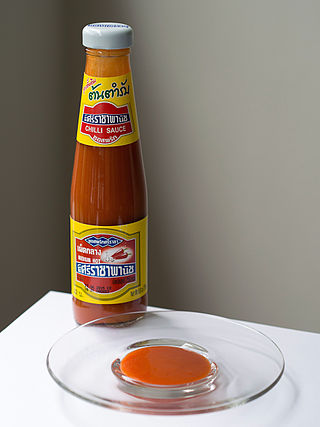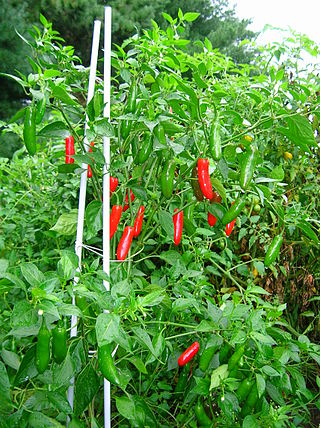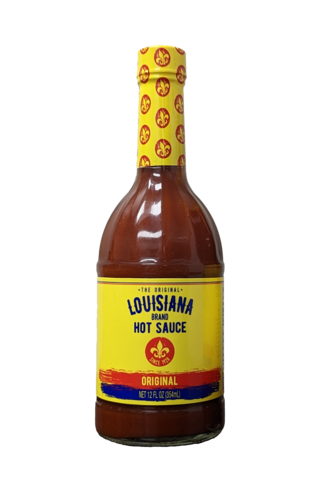
Tabasco is an American brand of hot sauce made from tabasco peppers, vinegar and salt. It is produced by McIlhenny Company of Avery Island in southern Louisiana, having been created over 150 years ago by Edmund McIlhenny. Originally the tabasco peppers were grown only on Avery Island; they are now primarily cultivated in Central America, South America and Africa. The Tabasco sauce brand also has multiple varieties including the original red sauce, habanero, chipotle, sriracha and Trinidad Moruga scorpion. Tabasco products are sold in more than 195 countries and territories, and packaged in 36 languages and dialects.

The Scoville scale is a measurement of pungency of chili peppers and other substances, recorded in Scoville heat units (SHU). It is based on the concentration of capsaicinoids, among which capsaicin is the predominant component.

An enchilada is a Mexican dish consisting of a corn tortilla rolled around a filling and covered with a savory sauce. Enchiladas can be filled with various ingredients, including meats, cheese, beans, potatoes, vegetables, or combinations. Enchilada sauces include chili-based sauces, such as salsa roja, various moles, tomatillo-based sauces, such as salsa verde, or cheese-based sauces, such as chile con queso.

Chili peppers, also spelled chile or chilli, are varieties of berry-fruit plants from the genus Capsicum, which are members of the nightshade family Solanaceae, cultivated for their pungency. Chili peppers are widely used in many cuisines as a spice to add "heat" to dishes. Capsaicin and the related capsaicinoids give chili peppers their intensity when ingested or applied topically. Chili peppers exhibit a range of heat and flavors. This diversity is the reason behind the availability of different types of chili powder, each offering its own taste and heat level.

Salsa encompasses a variety of sauces used as condiments for tacos and other Mexican and Mexican-American foods, and as dips for tortilla chips. They may be raw or cooked, and are generally served at room temperature.

A chipotle, or chilpotle, is a smoke-dried ripe jalapeño chili pepper used for seasoning. It is a chili used primarily in Mexican and Mexican-inspired cuisines, such as Tex-Mex and Southwestern United States dishes. It comes in different forms, such as chipotles en adobo.

Hot sauce is a type of condiment, seasoning, or salsa made from chili peppers and other ingredients. Many commercial varieties of mass-produced hot sauce exist.

Texas Pete is a brand of hot sauce in the United States developed and manufactured by the TW Garner Food Company in Winston-Salem, North Carolina. TW Garner was founded by Thad W. Garner in 1929. As of 2022, Texas Pete is the seventh-best selling hot sauce in the U.S., according to Instacart, an online grocery service.

Sriracha is a type of hot sauce or chili sauce made from a paste of chili peppers, distilled vinegar, pickled garlic, sugar, and salt.

Cholula Hot Sauce is a brand of chili-based hot sauce, based in Stamford, Connecticut, manufactured in Chapala, Jalisco, Mexico by SANE, and licensed by McCormick. According to its manufacturers, Cholula hot sauce rates 1,000–2,000 on the Scoville scale.

Chili sauce and chili paste are condiments prepared with chili peppers.

Tapatío is an American hot sauce produced in Vernon, California. It is popular in the United States, predominantly among Mexican-American communities.

The serrano pepper is a type of chili pepper that originated in the mountainous regions of the Mexican states of Puebla and Hidalgo. The Scoville rating of the serrano pepper is 10,000 to 25,000. The name of the pepper is a reference to the mountains (sierras) of these regions. The pepper is commonly used to make hot sauces.
Búfalo is a brand of hot sauce and other condiments produced by Herdez Group of Lomas de Chapultepec, Mexico. Búfalo sauce has been produced since 1933. The company produces Búfalo and Tampico sauces, salsas, and other condiments. In the United States, English-labeled bottles are distributed by MegaMex Foods, a joint venture between Herdez and Hormel Foods.

A guajillo chili or guajillo chile or chile guaco or mirasol chile is a landrace variety of the species Capsicum annuum with a mirasol chile fruit type. Mirasol is used to refer to the fresh pepper, and the term guajillo is used for the dry form, which is the second-most common dried chili in Mexican cuisine. The Mexican state of Zacatecas is one of the main producers of guajillo chilies. There are two main varieties that are distinguished by their size and heat factors. The guajillo puya is the smaller and hotter of the two. In contrast, the longer and wider guajillo has a more pronounced, richer flavor and is somewhat less spicy. With a rating of 2,500 to 5,000 on the Scoville scale, its heat is considered mild to medium.

Chili oil is a condiment made from vegetable oil that has been infused with chili peppers. Different types of oil and hot peppers are used, and other components may also be included. It is commonly used in Chinese cuisine, Southeast Asian cuisine, Italy, and elsewhere. It is particularly popular in Chinese cuisine, especially western Chinese cuisines such as Sichuan cuisine, Hunan cuisine, Guizhou cuisine, and Shaanxi cuisine where it is used as an ingredient in cooked dishes as well as a condiment. It is sometimes used as a dip for meat and dim sum. It is also employed in the Korean Chinese noodle soup dish jjamppong. A closely related condiment in Chinese cuisine is chili crisp, which contains edible chunks of food and chilis in oil.

The habanero is a hot variety of chili. Unripe habaneros are green, and they color as they mature. The most common color variants are orange and red, but the fruit may also be white, brown, yellow, green, or purple. Typically, a ripe habanero is 2–6 centimetres long. Habanero chilis are very hot, rated 100,000–350,000 on the Scoville scale. The habanero heat, flavor, and floral aroma make it a common ingredient in hot sauces and other spicy foods.

The Original Louisiana Brand Hot Sauce is a brand of hot sauce manufactured in New Iberia, Louisiana, by Summit Hill Foods. Bruce Foods was the previous owner and manufacturer of the brand and sold it to Summit Hill Foods in April 2015.


















